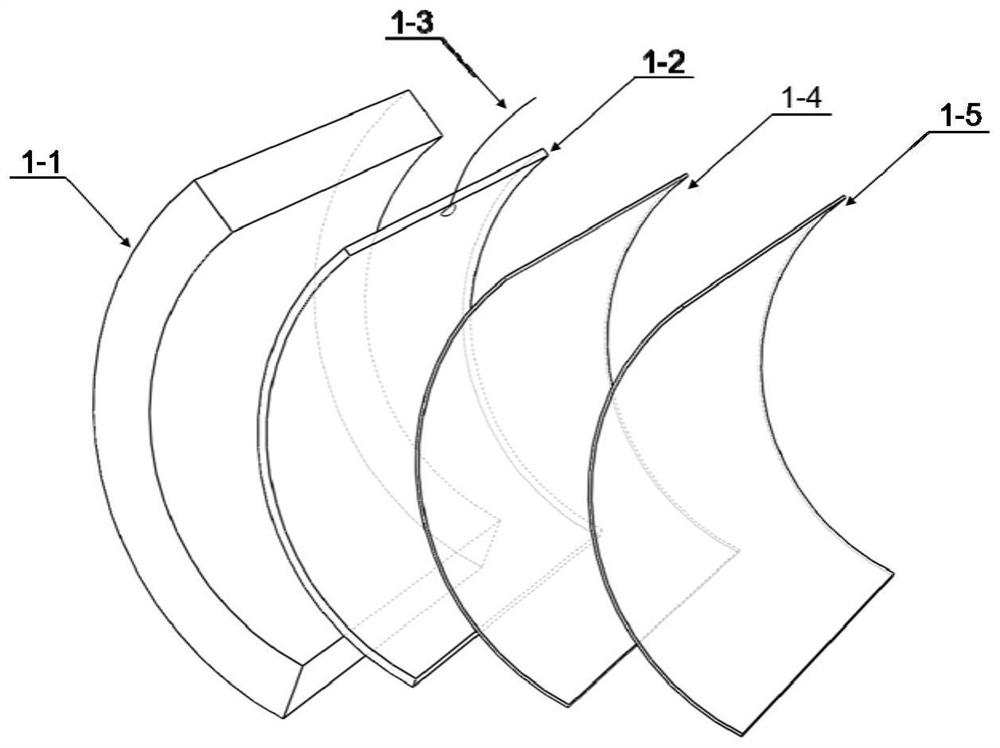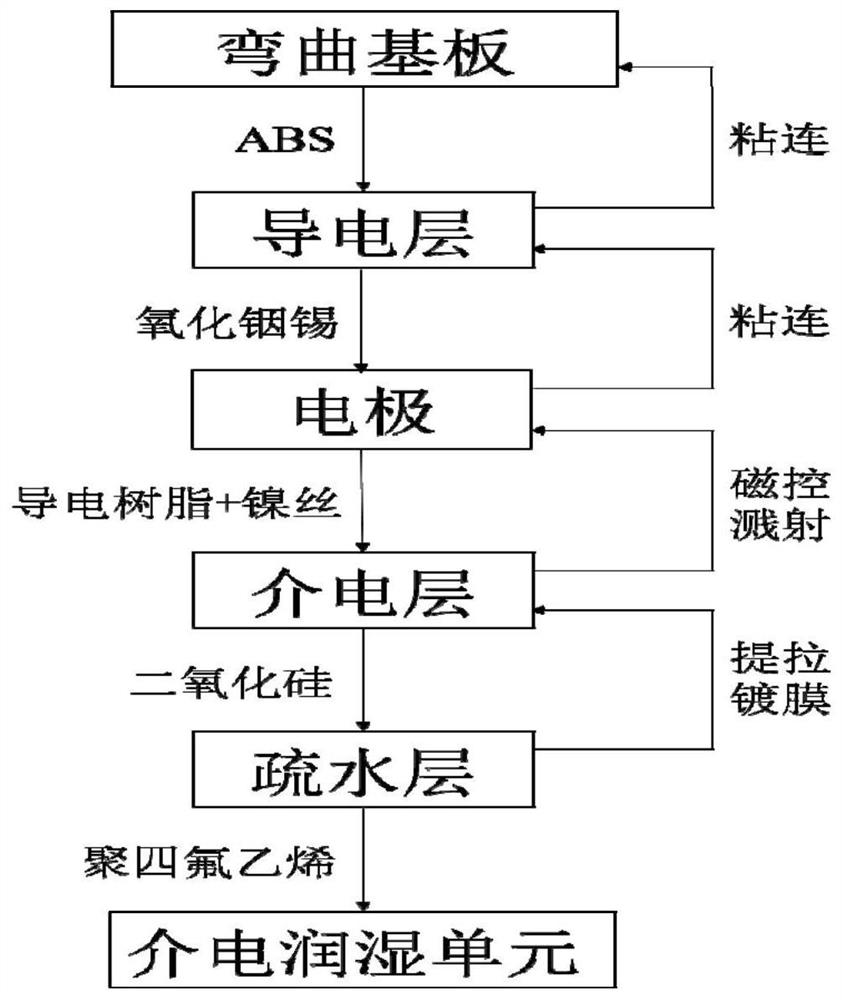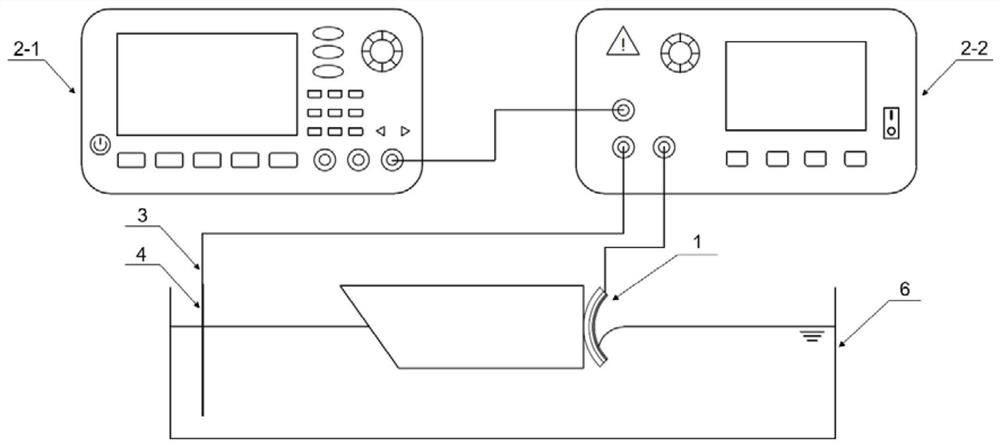Bent capillary wave propeller, production method and propelling system
A capillary wave and propulsion technology, applied in the field of mechanical engineering, can solve the problems of low capillary wave intensity, limited capillary wave amplitude, and limited propulsion capability, and achieves increased Coulomb force, increased repulsive force, and strong propulsion capability. Effect
- Summary
- Abstract
- Description
- Claims
- Application Information
AI Technical Summary
Problems solved by technology
Method used
Image
Examples
preparation example Construction
[0023] Such as figure 2 A preparation method of a curved capillary wave thruster shown, comprising:
[0024] Use a 3D printer to print the ABS material into a curved substrate 1-1 in the shape of a horizontal concave 120°;
[0025] Magnetron sputtering indium tin oxide onto the polyethylene terephthalate film to form a conductive layer 1-2, and affixing the conductive layer 1-2 with a thickness of 0.05 mm on the curved substrate 1-1;
[0026] Use a conductive resin to adhere the nickel wire to the conductive layer 1-2 and heat it for a certain period of time to form an electrode 1-3;
[0027] Magnetron sputtering silicon dioxide onto the upper surface of the conductive layer 1-2 with the electrodes 1-3 to form a dielectric layer 1-4;
[0028] Plating the polytetrafluoroethylene solution on the surface of the dielectric layer 1-4 to form a hydrophobic layer 1-5, immersing the curved substrate 1-1 with the dielectric layer 1-4 in a 5% polytetrafluoroethylene solution, using ...
Embodiment 1
[0032] A method for preparing a curved capillary wave propeller, comprising the following steps: using a 3D printer to print a curved substrate 1-1 with a curvature of 120°, the material is ABS, and the deformation temperature of the ABS is higher than the baking temperature in the subsequent steps, which can ensure The substrate is not deformed during the baking process. Adhere a 0.05 mm thick conductive film with indium tin oxide on the surface to the above-mentioned curved substrate 1-1, use conductive resin to fix the nickel wire on the conductive film on the upper end, put it in an oven and bake at 70°C for 60 minutes. After the conductive resin is solidified, magnetron sputtering of silicon dioxide onto the conductive resin and the electrodes 1-3 is used as the dielectric layer 1-4 of the curved capillary wave thruster to prevent the unit from being broken down after electrification. Use polytetrafluoroethylene solution as the hydrophobic layer 1-5 of the curved capillar...
Embodiment 2
[0034] A 120° curved capillary wave propeller was prepared according to the operation steps of Example 1, and this curved capillary wave propeller was added to the propulsion system as a water surface propeller.
[0035] Lightweight unmanned ships and aquatic micro-robots have extremely high requirements on their own weight. Traditional propulsion devices using mechanical structures such as motors and blades will greatly increase the weight and complexity of the propulsion device, thereby increasing the volume of the device and limiting its application scenarios . Compared with existing small propulsion devices, the capillary wave propulsion system based on the dielectric wetting effect does not rely on mechanical motion to achieve propulsion. When an alternating current is applied at both ends of the circuit, it will cause the oscillation of the contact angle of the liquid on the surface of the capillary wave thruster, and the change of the contact angle will cause the displa...
PUM
| Property | Measurement | Unit |
|---|---|---|
| Thickness | aaaaa | aaaaa |
| Diameter | aaaaa | aaaaa |
Abstract
Description
Claims
Application Information
 Login to View More
Login to View More - R&D
- Intellectual Property
- Life Sciences
- Materials
- Tech Scout
- Unparalleled Data Quality
- Higher Quality Content
- 60% Fewer Hallucinations
Browse by: Latest US Patents, China's latest patents, Technical Efficacy Thesaurus, Application Domain, Technology Topic, Popular Technical Reports.
© 2025 PatSnap. All rights reserved.Legal|Privacy policy|Modern Slavery Act Transparency Statement|Sitemap|About US| Contact US: help@patsnap.com



